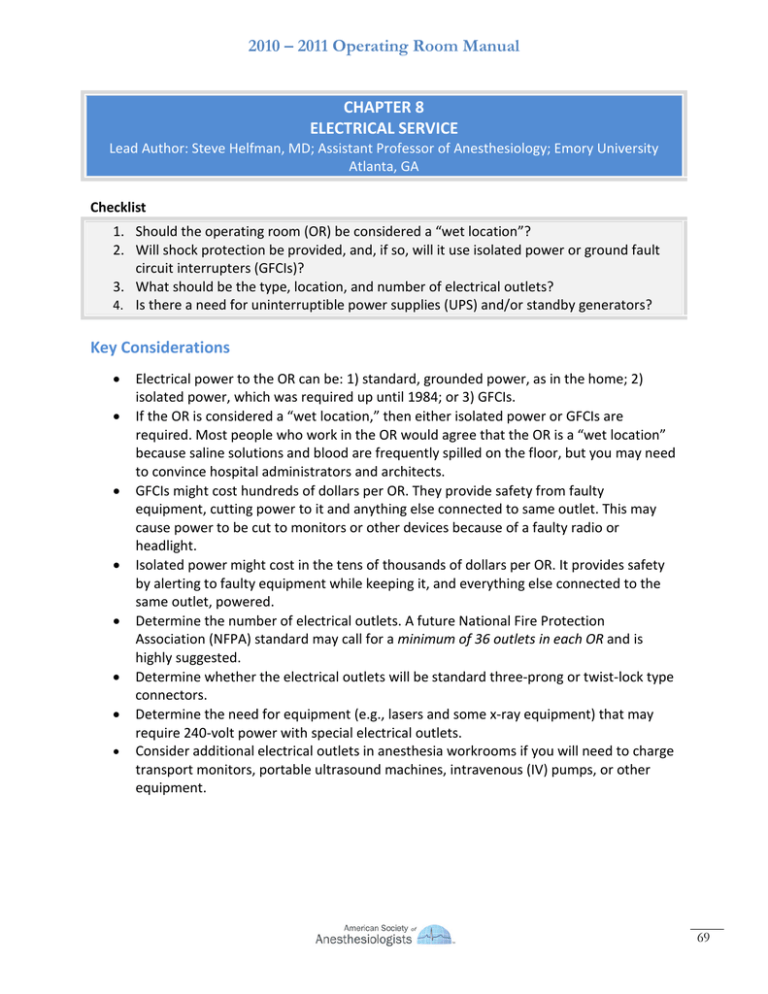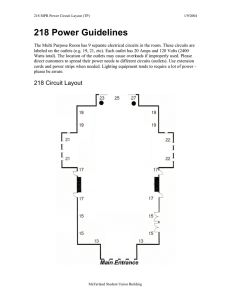Chapter 8: Electrical Service - American Society of Anesthesiologists
advertisement

2010 – 2011 Operating Room Manual CHAPTER 8 ELECTRICAL SERVICE Lead Author: Steve Helfman, MD; Assistant Professor of Anesthesiology; Emory University Atlanta, GA Checklist 1. Should the operating room (OR) be considered a “wet location”? 2. Will shock protection be provided, and, if so, will it use isolated power or ground fault circuit interrupters (GFCIs)? 3. What should be the type, location, and number of electrical outlets? 4. Is there a need for uninterruptible power supplies (UPS) and/or standby generators? Key Considerations • • • • • • • • Electrical power to the OR can be: 1) standard, grounded power, as in the home; 2) isolated power, which was required up until 1984; or 3) GFCIs. If the OR is considered a “wet location,” then either isolated power or GFCIs are required. Most people who work in the OR would agree that the OR is a “wet location” because saline solutions and blood are frequently spilled on the floor, but you may need to convince hospital administrators and architects. GFCIs might cost hundreds of dollars per OR. They provide safety from faulty equipment, cutting power to it and anything else connected to same outlet. This may cause power to be cut to monitors or other devices because of a faulty radio or headlight. Isolated power might cost in the tens of thousands of dollars per OR. It provides safety by alerting to faulty equipment while keeping it, and everything else connected to the same outlet, powered. Determine the number of electrical outlets. A future National Fire Protection Association (NFPA) standard may call for a minimum of 36 outlets in each OR and is highly suggested. Determine whether the electrical outlets will be standard three-prong or twist-lock type connectors. Determine the need for equipment (e.g., lasers and some x-ray equipment) that may require 240-volt power with special electrical outlets. Consider additional electrical outlets in anesthesia workrooms if you will need to charge transport monitors, portable ultrasound machines, intravenous (IV) pumps, or other equipment. 69 2010 – 2011 Operating Room Manual Electrical Power There are three ways to provide electrical power to the OR: 1) standard, grounded power, as in the home; 2) isolated power, which was required up until 1984; and 3) GFCIs. With the common type of grounded power that is supplied to the home, it is relatively easy for an individual to become part of an electrical circuit and receive a potentially harmful electric shock. GFCIs are commonly installed in “wet locations” (e.g., bathrooms and kitchens) in the home in order to provide protection against electric shock. The GFCI will interrupt the power in the event that a hazardous current is flowing. All electrical devices on that branch circuit will have the power supply interrupted. The standards, codes, and Joint Commission requirements revolve around two issues. If the OR is considered a “wet location,” then either isolated power or GFCIs are required. Most people who work in the OR would agree that the OR is a “wet location” because saline solutions and blood are frequently spilled on the floor. Discussions are underway within the NFPA to declare that all ORs are “wet locations” or to declare that they are “wet locations” by default, with local risk management able to determine that they are not wet locations. Members of the American Society of Anesthesiologists Committee on Equipment and Facilities have been unanimous in their opinion that all ORs are “wet locations.” The design team must decide whether to provide isolated power supply or GFCIs. Administrators may look upon this issue as a way to save money. There is a large cost differential between GFCI and isolated power. GFCIs might cost hundreds of dollars per OR, while isolated power might cost between $5000 and $9000 per isolation panel, with one or more panels used per OR. If isolated power is selected, malfunctioning equipment will generate an alarm but will not automatically shut off. Many anesthesiologists prefer this approach. The drawback of isolated power, however, is that in many cases, it is difficult to identify which piece of equipment has malfunctioned and is causing the alarm. Furthermore, isolated power systems generate the alarm based upon the total leakage current, and, with many different pieces of electrical equipment connected, each individual piece of equipment may be within its leakage specifications yet the total current is above the leakage limit. Thus, there is no “malfunction” and, yet, the alarm is sounding. 70 2010 – 2011 Operating Room Manual If GFCIs are selected, then malfunctioning equipment will be automatically shut off. It is generally simple to identify the equipment that has automatically shut off and plug it into a different circuit. The automatic shutoff could pose safety issues, however, if monitors or lifesupport equipment suddenly lose power. Life-support devices (e.g., ventilators, cardiopulmonary bypass machines, etc.) commonly contain internal battery backup. If other necessary equipment (e.g., fixed patient monitors) lack internal battery backup, freestanding UPS can be used between the GFCI outlet and the piece of equipment. Adding freestanding UPS to a GFCI system remains less expensive than an isolated system. Figure 1 71 2010 – 2011 Operating Room Manual Every health care facility must have a source of emergency power. This is usually a generator that is capable of supplying a significant amount of the facility’s electrical power requirements in the event that the local electrical utility company experiences a power failure. Emergency outlets in the OR (and elsewhere in the hospital) are commonly colored red, and if the main electrical service is lost, only these red outlets will continue to supply electricity. If stored fuel is used to power on-site generators, there must be enough storage capacity for at least 24 hours of continuous operation. Although various codes may dictate that a minimum number of electrical outlets in the OR and postanesthesia care unit be connected to the emergency generator, it is desirable to have all of them connected. Electrical Outlets Standards call for operating and delivery rooms to have at least six receptacles convenient to the head of the procedure table and for each OR to have at least eight duplex receptacles. In today’s environment, most would consider that woefully inadequate. A future NFPA standard may call for a minimum of 36 outlets in each OR. It is far better to have too many than too few electrical outlets. Although it is possible to identify and quantify the electrical requirements for modern day OR equipment, it is impossible to predict how much electrical equipment will be used in the ORs of the future. Therefore, electrical outlets should be placed on every wall. Also, in order to help reduce the hazard of multiple electrical cords on the floor, outlets also should be placed in the ceiling and gas/electric columns. These can be located at the head of the bed on both sides of the OR table or both sides of the anesthesia workstation and are useful for plugging in monitors, infusion pumps and fluid warmers. Figure 2 72 2010 – 2011 Operating Room Manual Figure 3 Ceiling outlets at the foot of the table can be used for many pieces of surgical equipment. Cords can be plugged into the ceiling outlet, extending to 6.5 to 7 feet from the floor. Figure 4 The electrical outlets can have either the standard three-prong or twist-lock type connectors. Virtually all hospital electrical equipment comes with three-prong plugs. Twist-lock plugs were an older replacement for explosion-proof connectors that were required in the days of flammable anesthetics. Twist-lock plugs provide some protection against accidental disconnection. 73 2010 – 2011 Operating Room Manual Twist-lock plugs on OR equipment were once very popular in order to prevent the equipment from “wandering” to other parts of the hospital because other areas of the hospital lacked the correct electrical outlets to plug in the equipment. Over time, adapter cables (from standard to twist-lock and from twist-lock to standard) appeared throughout the hospital. These adapter cables posed additional expense and hazard, and most hospitals have abandoned the twist-lock connectors. GFCI circuits are not readily available with twist-lock outlets. Figure 5 Certain equipment (e.g., lasers and some x-ray equipment) may require 208- or 240-volt power, with special electrical outlets. The need for these outlets and their location within each OR need to be anticipated in the design phase. If anesthesia workrooms will be used to charge transport monitors, portable ultrasound machines, IV pumps, or other equipment, appropriate electrical service should be provided for this purpose. 74 2010 – 2011 Operating Room Manual Bibliography American Institute of Architects Academy of Architecture for Health. Guidelines for Construction and Equipment of Hospital and Health Care Facilities. Washington, DC: AIA Press; 2010. Association of Operating Room Nurses. Recommended practices. Traffic patterns in the surgical suite. AORN J. 1993;57(3):730-734. Azar I, Eisenkraft JB. Waste, anesthetic gas spillage and scavenging systems. In: Ehrenwerth J, Eisenkraft JB, eds. Anesthesia Equipment: Principles and Applications. St. Louis, MO: Mosby; 1993:114-139. Dorsch JA, Dorsch SE. Understanding Anesthesia Equipment, Construction, Care, and Complications. 3rd ed. Baltimore, MD: Williams & Wilkins; 1994. ECRI. Medical gas and vacuum systems. Health Devices. 1994;23(1-2):4-53. Ehrenwerth J. Operating room design. ASA Newsletter. 1994(Nov);58:13-16. Ehrenwerth J, Seifert HA. Electrical and fire safety. In: Barash PG, Cullen BF, Stoelting RK, eds. Clinical Anesthesia. 6th ed. Philadelphia, PA: Lippincott, Williams & Wilkins; 2009. Eichhorn JH, Ehrenwerth J. Medical gases: storage and supply. In: Ehrenwerth J, Eisenkraft JB, eds. Anesthesia Equipment: Principles and Applications. St. Louis, MO: Mosby; 1993:3-26. Gowin J. The nurse’s view of operating room design and function. Anesthesiology. 1969;31(2):181-185. MacDonald AG. A short history of fires and explosions caused by anesthetic agents. Br J Anaesth. 1994;72(6):710-722. National Fire Protection Association. NFPA 70: National Electrical Code. Quincy, MA: National Fire Protection Association; 2008. National Fire Protection Association. NFPA 99: Standards for Health Care Facilities. Quincy, MA: National Fire Protection Association; 2005. Seifert HA. Fire safety in the operating room. Progr Anesthesiol. 1994; 8:31-40. TWIST-LOCK® and HUBBELLOCK® Devices. Hubbel Incorporated Online Catalog [Web site]. Section b:75. Available at: http://www.hubbellcatalog.com/wiring/catalogpages/section-b.pdf. 75




